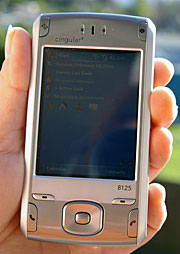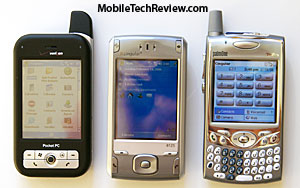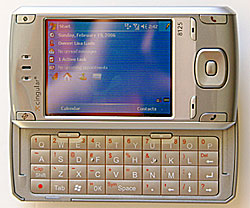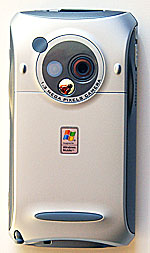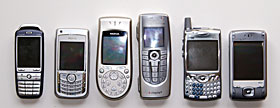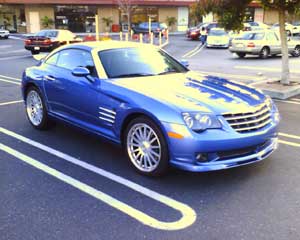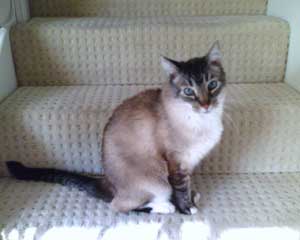
|
||||||||||||
The 8125's front face sports a gloss dark silver finish that's accented with light silver. The sides and back aren't high gloss and that's a good thing: the unit isn't slippery in the hand. A rubber ridge that runs across the back helps keep the phone in hand and prevents it from sliding across the table or dancing on the desk when the ringer is set to vibrate. The phone's back corners are curved, making the somewhat thick device feel good in hand, even after long conversations. The 2.8" display dominates the front face and there are two application buttons above the display to launch the email and web browsing applications. Call send and end buttons flank the roomy five-way directional pad and the device has two soft keys to support Windows Mobile 5's soft key feature. The volume slider (sets PDA and ringer volume when not in a call and earpiece volume when in a call) lives on the upper left side as does the button to launch Comm Manager which handles the wireless radios among other things. Press and hold the Comm Manager button to turn off the ringer and PDA sounds and turn vibrate on. Press and hold it again to re-enable sounds. On the right you'll find buttons to launch voice dialing and the camera along with the IR window. Dual side-firing speakers (one on each side) handle the speakerphone output which is adequate and better than its CDMA cousin the Apache which uses only the earpiece for speakerphone output. The stylus slides out from the bottom and is a terribly small, telescoping toothpick. The camera lens, self portrait mirror and LED flash are located in a circle of contrasting dark gray surrounded by the words "1.3 mega pixels camera" on Cingular 8125's back. The design intends to show off the camera phone, making it look like a camera when held horizontal to take a shot. The battery is located under the removable back cover and the SIM card lives under the battery. The Mini SD card slot is located up top as is the power button while the sync port is at the bottom. Like most recent HTC Pocket PC and Windows Mobile Smartphones, the 8125 has a mini USB jack for syncing and charging. Though you can't plug both in at once, the PDA will charge over USB.
Horsepower and Performance 195 MHz? Doesn't make your heart race with excitement if you're a geek addicted to "the bigger the better" kinds of numbers. But wait: let's pretend you didn't know the CPU speed and someone gave you this unit to play with for an hour. Unless you were playing back video encoded above 500 kbps, you'd probably guess the Cingular 8125 was a 312 or 400 MHz unit. That's the common range of speeds for Windows Mobile 5.0 Pocket PC phones and the 8125 feels middle of the pack when it comes to dropping down menus, launching applications, using Pocket Word, Internet Explorer or even playing action games and music. Pocket PC phones run from 312 to 416 MHz these days, with the Treo 700w and the HP iPAQ hw6515 being at the low end and the HTC Universal (the big VGA device that looks like a tiny notebook), Apache (Sprint PPC-6700 and Verizon XV6700) and E--TEN M600 being at the high end. If you're looking for a phone that can do some serious video playback or don't want to be bothered keeping track of running programs (and closing some of them when the device slows down) then the 8125 or ANY of the other Wizard variants aren't for you. If you're looking for decent performance (other than video playback and Skype reliability at this point), and crave great battery life by PPC phone standards, the Cingular 8125 should be on your short list. The lower the megahertz, the better the battery life, and the 8125 lasts considerably longer on a charge than many other PPC phones with faster CPUs. Texas Instruments makes the 195 MHz OMAP850 dual core processor and it has one core which handles PDA functions and another that's basically a DSP handling telephony and some multimedia duties. We normally include Spb Benchmark results, however that application isn't updated very often lately and has trouble running all tests to conclusion on several Windows Mobile 5 devices including the 8125. Do check out the benchmarks in our T-Mobile MDA review, as they should be representative of the hardware in question. The 8125 has 128 megs of flash ROM and 64 megs of RAM. Under Windows Mobile 5, RAM is used in the same way it is on a PC: it's the place where running programs execute. The operating system and pre-installed applications live in Flash ROM and the remaining 45 megs are available for you to install programs and data. Should you need more space for programs and files, you can get a Mini SD card to use with the 8125. Typically there are 28 megs of free RAM so the device rarely runs short on memory.
Phone Features, Data and Reception The Cingular 8125 is a quad band GSM world phone (850/900/1800/1900 MHz) that will work anywhere in the world GSM service is available. You'll have to use a Cingular SIM with the phone however, since it's locked to Cingular. That said, it's easy to find ways to unlock the phone on the web. For fast (but not 3G fast) data the 8125 has EDGE class 10 as well as the older, slower GPRS standard. Though Cingular has 3G up in several cities, they've yet to offer a phone that uses that much faster wireless data standard. When you have a need for more speed and are in range of an access point, turn on the device's WiFi radio. Data speeds over EDGE in the Silicon Valley area were impressive, coming in between 150 and 180k when using Cingular's default proxy setting for their MEdia Net service. When not using the proxy, speeds ranged from 100 to 110k. Like all Windows Mobile phones, the 8125 comes with mobile versions of Internet Explorer and Outlook (the email component is called Messaging) so you can stay in touch when on the go. Since choice is a good thing, also try out the beta of Opera for Windows Mobile 5 PPCs and NetFront 3.3 technical preview, both of which are free until the release versions are ready. These two excellent browsers offer some features that IE lacks, so it's worth a look if you spend a lot of time web browsing. The 8125 supports MMS and SMS, both of which use Messaging to manage communications. Update: Cingular announced a free AKU2 upgrade which offers Microsoft Direct Push email, available June 19, 2006. You can read more here. If you purchased your 8125 after this date it may have the AKU2 update pre-installed. Voice is a pleasure on the 8125 which features clear conversations and adequate volume when talking directly to the handset. When using the included earbud headset, call clarity was also excellent and volume could get downright deafening (that's what that volume slider is for The phone supports common call features such as call forwarding, conference calling, call waiting and it has a full duplex speaker phone that's adequate but not stellar despite the two speakers. It is louder than the Apache models and clearer. Now here's my favorite: voice dialing that works over Bluetooth. Yes, that's still a rarity on Pocket PC phones which is unfathomable since every decent feature phone with Bluetooth can do it. The 8125 ships with Voice Speed Dial which uses voice tags rather than true speech recognition. Yes it lacks Microsoft Voice Command's impressive recognition capabilities and range of commands but MS Voice Command does eat up a lot of resources and won't work over a Bluetooth headset or car kit. You can record tags for any contact in your address book and you can record tags to launch the applications of your choice. To initiate voice commands simply press the dedicated button on the right side of the phone or press (press and hold for some headsets) the call button on your Bluetooth headset or car kit. Display, Multimedia and Gaming The Cingular 8125 has a very bright, clear QVGA 240 x 320 transflective color display that's among our favorites. The display supports 65,000 colors and both portrait and landscape modes. The screen has sharp contrast, pleasing color saturation and is plenty bright at the 50% setting. Indoors it looks great, though outdoors, glare is noticeable. Like most recent Pocket PC Phone Edition models, the 8125 has a 2.8" LCD rather than the 3.5" one found on older PPC phones and non-phone PPCs. Text looks sharper on the smaller screen, and is quite readable. Sound out through the included stereo earbud headphones is good when listening to MP3s using the included Windows Media Player Mobile 10 with support for DRM. Likewise movie soundtracks sound good, and certainly much better than the speaker, as is the case with all PDAs. The PDA does well with video encoded at 500 kbps or less and QVGA resolution using Windows Media Player and the excellent free TCPMP video player. Volume for both PDA audio and ringtones is average through the built-in speaker. To test video playback we threw our usual
test file at it: "The Chosen" (a neat BMW flick with
Clive Owen) which is a 4:26 minute long, 10 meg MPEG1 file recorded
at 320 x 240, 308 kb/s. We tested the Cingular 8215 using TCPMP,
an extremely fast open source free video player that supports
MPEG1, DivX, ASF, WMV and AVI files. TCPMP benchmarked "The
Chosen" with passable benchmarks of: The phone does a great job with games thanks to its large and responsive d-pad. Even action and demanding games didn't phase the 8125 when we tested Sky Force, Ancient Evil and the less demanding Bejeweled 2 among others. Don't get your hope up for great NES emulator performance, but most any other Windows Mobile 5 compatible game should run fine despite the 195 MHz processor. Camera
Sample photos taken at 1280 x 1024 resolution in superfine mode, auto ambiance. Photos are resized to fit this page but are otherwise unedited.
WiFi and Bluetooth EDGE is nice but WiFi is sweet when you want those web pages and emails to download pronto. And for those of you who don't subscribe to Cingular's unlimited data plan, WiFi is a must, assuming you have an access point at home, work or wherever you wish to use the device for Internet access. To turn on WiFi, use the Comm Manager application (press the dedicated button, tap on the icon at the bottom of the home screen or run it from the Programs group). Tap on the WiFi icon in Comm Manager to turn on WiFi and the Windows Mobile Connection Manager (a part of the OS) takes over and notifies you of available access points or automatically connects you to one you've used in the past if it's in range. You can get to WiFi settings by selecting them from the menu in Comm Manager or by tapping on the Wireless LAN icon under Settings->Connections. Here you'll see information about your current connection (SSID, mode, channel, IP, MAC address, power mode (user settable) and tab where you can set up a secure certificate. Should you need something more fancy that can show you access points in range and more, check out the free WiFiFoFum 2. We're not sure what chip the 8125 uses but it supports both b and g modes (there's a registry hack to enable g mode only, but you won't see huge performance improvements because the Pocket PC CPU speed and architecture are bottlenecks). Still, it's handy if you need to connect to the rare g-only access point or don't want your network to drop down to the slower b mode. Range is good by Pocket PC standards and the device holds signal well. Out of the box, the device switched easily between EDGE using Cingular's Media Net service and WiFi. However, after we installed Netfront 3.3 technical preview, the device connected correctly to access points and could get email, but not surf. It seems something in the registry was changed and IE (along with Netfront) picked up the proxy settings for the MEdia Net connection and tried to apply them to WiFi, which will not work. Should your 8125 not surf using WiFi, you'll either need to uncheck the proxy setting (wireless.cingular.com at port 80) under Settings-> Connections or create a new connection that doesn't use the proxy. Or use Opera, which doesn't attempt to use the EDGE proxy settings when connected via WiFi. Hopefully Cingular will update the device at some point with new settings that don't apply the proxy to every darned connection. Keep in mind that you'll want to use the proxy when surfing using EDGE or GPRS because it speeds up things by 50k or so. Why? Proxies can act as caching and/or compression servers which speeds up downloads. Bluetooth, in contrast, just works. The Cingular 8125 has Bluetooth 1.2 which is backward compatible with 1.1. It supports headsets and has the handsfree profile along with serial port, file transfer, DUN (dial up networking for using the phone as a wireless modem for a notebook) but not A2DP (high quality stereo audio). The setup software is basic since it uses Microsoft's spartan Bluetooth stack and software, but it gets the job done. We tested the phone as a modem for a Windows XP machine, and it worked fine. We tested the phone with the Plantronics Discovery 640 headset and audio quality and range were good (the 640 doesn't have stellar range since it's a small headset but it did relatively well with the 8125). Voice dialing over Bluetooth worked well too (press and hold the call button on the headset to initiate voice dialing). We also tested Motorola's HF800 car kit and sound quality was excellent. Again, voice dialing worked well: with the Moto, press the call button quickly rather than holding it down as with the Plantronics. Software All Windows Mobile 5.0 Pocket PCs come with the operating system, Mobile Office suite including Outlook Mobile and desktop Outlook, Windows Media Player Mobile 10, Terminal Services, Pictures and Videos, Pocket MSN (Hotmail, MSN Messenger), File Explorer, handwriting recognition (print and cursive), Solitaire, Bubble Breaker (the game formerly known as Jaw Breaker), Calculator and support for secure certificates and VPN connections. Outlook on the PDA has calendar, contacts, tasks, notes and email (called Messaging), which you can sync to a Windows desktop running Outlook. In addition you get Clear Storage (wipes out the device to factory settings), ClearVue PDF viewer, Comm Manager, a link to download the GoodLink client, the camera application, Voice Speed Dial, Tao Group's Java MIDlet Manager (unlike the T-Mobile MDA, the 8125 comes with a Java VM), Modem Link, Zip (unzips .zip files) and Cingular's Xpress Mail (push email service that pushes email from your desktop to the 8125). You can add any Windows Mobile 5 Pocket PC app you wish and we tested several which ran well , including Resco File Explorer, Resco Photo Viewer, TCPMP, Ilium Software's eWallet, eReader, Opera beta, Netfront 3.3 technical preview and a host of games. Battery Life Battery life, compared to feature phones, don't earn Pocket PC phone's bragging rights. But that large display, excellent web and email presentation and mini-PC-in-your-hand experience makes us forgive their relatively short run times. That said, the 8125 (and the Wizard in general), is a shining star, easily lasting two days with moderate use (40 minutes phone time total using a Bluetooth headset, surfing the web over EDGE for 1.5 hours total, using WiFi and the web for 30 minutes more, and checking email and PIM data several times per day with Bluetooth always on). That scenario would send the Samsung i730 to the charger before the first day's end and the XDA III (Siemens SX66) to the charger by day's end. Thank the heavens for that 195 MHz CPU when it comes to battery life: it uses much less power than most 400 MHz units. If you're a very heavy phone and data user, or are addicted to WiFi, do expect to charge nightly. If you're a moderate user then expect two days on a charge and light users will get three (or four) days on a charge. Conclusion We've come a long way in a year: not only do we have healthy a selection of juicy PPC phones on sale by all US carriers, but Cingular now offers a phone that's leaps and bounds better than the Siemens SX66. The Cingular 8125 is compact, stable and runs the latest Windows Mobile OS. This phone is attractive, well-made and somehow manages to shoehorn every imaginable feature into a small package. We love the bright, colorful display, roomy keyboard and good voice quality. EDGE, WiFi and Bluetooth will keep you connected to most anything, anywhere and Cingular's EDGE speeds on their MEdia Net plan are impressive. Though not the fastest kid on the block, the 8125 does have very good battery life by PPC standards and runs most apps quickly enough, even games. The 8125 loses a half star to the PPC-6700 and XV6700 only because it lacks 3G, which is an important feature for a data-centric device. Though we don't give 1/4 stars, we wish we could add one to move this device just above the 4 star K-JAM since the 8125 has a better keyboard and more attractive and ergonomic casing. If you're also considering the HP iPAQ hw6515, we say the Cingular 8125 beats it (unless you need the iPAQ's integrated GPS) because the iPAQ has a lower resolution 240 x 240 display and runs the old 2003SE OS. Pro: Compact, attractive and well built. Great display and decent camera. EDGE, WiFi and Bluetooth will keep you connected. Very good voice quality and the phone supports voice dialing over Bluetooth using the included software. Good reception and battery life. Stable and responsive by Windows Mobile 5 standards. Very attractive pricing for a Pocket PC phone. Comes with a Java VM. Con: Cingular's MEdia Net connection settings (proxy) can cause problems using Internet Explorer over WiFi which means you have to twiddle with connection settings. Not the right device for speed demons and those who want to play videos encoded at high bitrates (or larger than QVGA resolution) or run game emulators. Make sure you don't have more than 5 running programs or the phone will slow down (get a task manager to make exiting apps easier). Not a one-handed device (unless you want to do some hacking to change button assignments, a la Smartskey). Price: approx. $349 with a 2 year contract Web Site: wireless.att.com
| ||||||||||||
